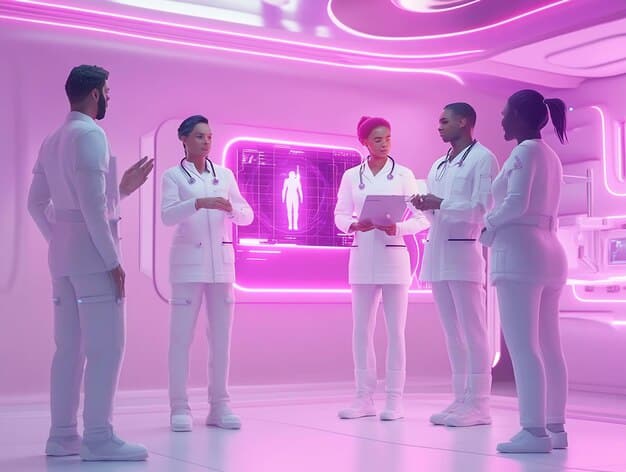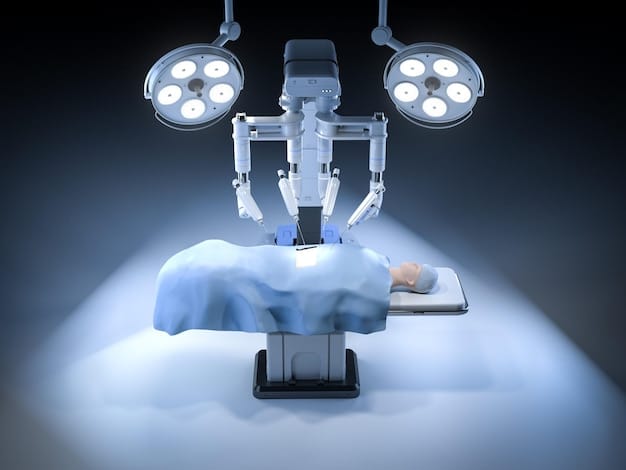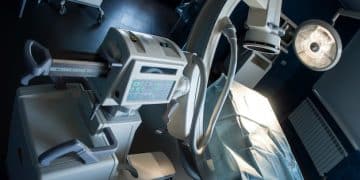US MedTech Startup Trends: 5 Innovations Shaping Healthcare in 2025

US MedTech startup trends in 2025 are poised to revolutionize healthcare through innovations like AI-driven diagnostics, personalized medicine, advanced wearables, robotic surgery, and telehealth solutions, enhancing patient outcomes and streamlining healthcare delivery.
The landscape of healthcare is rapidly evolving, and US MedTech startup trends: 5 innovations shaping the future of healthcare in 2025 are at the forefront of this transformation. These innovative companies are driving advancements that promise to revolutionize patient care, improve outcomes, and streamline healthcare delivery across the nation.
The Rise of AI-Driven Diagnostics
Artificial intelligence (AI) is rapidly transforming medical diagnostics. US MedTech startups are leveraging AI to develop more accurate, efficient, and accessible diagnostic tools, enabling earlier and more precise disease detection.
AI-driven diagnostics are not just about speed; they are about improving accuracy and reducing human error. This technology promises to enhance the overall quality of healthcare delivery.
AI in Medical Imaging
One of the most promising applications of AI in diagnostics is medical imaging. AI algorithms can analyze X-rays, CT scans, and MRIs with remarkable precision, often surpassing the capabilities of human radiologists.
Predictive Analytics for Disease Detection
AI is also being used to develop predictive analytics tools that can identify individuals at high risk of developing certain diseases. By analyzing patient data and identifying patterns, these tools can help healthcare providers implement preventive measures and early interventions.
- Enhanced Accuracy: AI algorithms provide more precise diagnoses.
- Faster Results: AI can analyze data and provide results much faster than traditional methods.
- Improved Efficiency: AI automates tasks, freeing up healthcare professionals to focus on patient care.
- Reduced Costs: Early detection and preventive measures can significantly reduce healthcare costs.
The integration of AI in diagnostics is poised to transform healthcare by making early and accurate disease detection more accessible. As these technologies continue to advance, they promise to save lives and improve patient outcomes across the US.

Personalized Medicine: Tailoring Treatments to the Individual
Personalized medicine is revolutionizing healthcare by tailoring treatments to the individual characteristics of each patient. US MedTech startups are at the forefront of this movement, developing innovative solutions that leverage genetic information, lifestyle factors, and other data to optimize treatment strategies.
This approach moves away from the one-size-fits-all model and focuses on providing the right treatment to the right patient at the right time.
Genetic Testing and Analysis
Genetic testing plays a crucial role in personalized medicine. US MedTech startups are developing advanced genetic testing platforms that can identify genetic markers associated with various diseases and predict an individual’s response to specific treatments.
Data-Driven Treatment Plans
By combining genetic information with other patient data, such as medical history, lifestyle factors, and environmental exposures, personalized medicine startups are creating data-driven treatment plans that are tailored to each patient’s unique needs.
- Improved Treatment Outcomes: Personalized treatments are more effective and have fewer side effects.
- Reduced Healthcare Costs: By avoiding ineffective treatments, personalized medicine can reduce healthcare costs.
- Enhanced Patient Engagement: Patients are more engaged in their care when they understand how treatments are tailored to their specific needs.
- Preventive Care: Personalized medicine can help identify individuals at risk of developing certain diseases, allowing for preventive interventions.
Personalized medicine promises to transform healthcare by making treatments more effective, efficient, and patient-centered. As these technologies continue to evolve, they will play an increasingly important role in improving healthcare outcomes across the US.
The Expansion of Advanced Wearable Technology
Advanced wearable technology is becoming an integral part of healthcare, offering continuous monitoring of vital signs and other health metrics. US MedTech startups are developing innovative wearables that provide valuable insights into patient health, enabling proactive interventions and personalized care.
These devices are not just about tracking fitness; they are about providing real-time data that can help healthcare providers make informed decisions and improve patient outcomes.
Remote Patient Monitoring
Wearable technology enables remote patient monitoring, allowing healthcare providers to track patients’ health from a distance. This is particularly valuable for individuals with chronic conditions, such as diabetes and heart disease.
Early Detection of Health Issues
Advanced wearables can detect subtle changes in vital signs that may indicate an emerging health issue. This allows for early intervention, potentially preventing serious complications.
- Continuous Monitoring: Wearables provide continuous monitoring of vital signs and other health metrics.
- Real-Time Data: Healthcare providers have access to real-time data, enabling timely interventions.
- Improved Patient Engagement: Patients are more engaged in their health when they can track their progress and see the impact of their lifestyle choices.
- Reduced Hospitalizations: Remote patient monitoring can help prevent hospitalizations by enabling proactive interventions.
The expansion of advanced wearable technology is poised to transform healthcare by making it more proactive, personalized, and accessible. As these devices become more sophisticated and integrated into healthcare systems, they will play an increasingly important role in improving patient outcomes and reducing healthcare costs.
Robotic Surgery: Precision and Minimally Invasive Procedures
Robotic surgery is revolutionizing surgical procedures by offering enhanced precision, dexterity, and control. US MedTech startups are developing advanced robotic surgical systems that enable minimally invasive procedures, reducing patient trauma and recovery times.
This technology is not just about automation; it is about enhancing the capabilities of surgeons and improving patient outcomes.
Enhanced Surgical Precision
Robotic surgical systems provide surgeons with enhanced precision and control, allowing them to perform complex procedures with greater accuracy.
Minimally Invasive Techniques
Robotic surgery enables minimally invasive techniques, reducing patient trauma, blood loss, and recovery times.
- Reduced Pain: Minimally invasive procedures result in less pain and discomfort for patients.
- Shorter Hospital Stays: Patients undergoing robotic surgery typically have shorter hospital stays.
- Faster Recovery: Minimally invasive techniques allow for faster recovery and return to normal activities.
- Improved Outcomes: Robotic surgery can lead to improved outcomes, particularly for complex procedures.
Robotic surgery is transforming the field of surgery by making procedures safer, more effective, and less invasive. As these technologies continue to advance, they will play an increasingly important role in improving patient outcomes and reducing healthcare costs.

Telehealth: Expanding Access to Healthcare
Telehealth is expanding access to healthcare by bringing medical services to patients remotely through technology. US MedTech startups are developing innovative telehealth solutions that enable virtual consultations, remote monitoring, and other services, improving access to care for individuals in underserved areas and those with limited mobility.
This technology is not just about convenience; it is about ensuring that everyone has access to quality healthcare, regardless of their location or circumstances.
Virtual Consultations
Telehealth enables virtual consultations, allowing patients to connect with healthcare providers remotely through video conferencing and other technologies.
Remote Monitoring of Chronic Conditions
Telehealth also facilitates remote monitoring of chronic conditions, allowing healthcare providers to track patients’ health and provide timely interventions.
- Improved Access: Telehealth improves access to healthcare for individuals in underserved areas and those with limited mobility.
- Reduced Costs: Telehealth can reduce healthcare costs by avoiding unnecessary in-person visits and hospitalizations.
- Convenience: Telehealth offers convenience for patients, allowing them to access care from the comfort of their own homes.
- Improved Outcomes: Telehealth can lead to improved outcomes by enabling timely interventions and personalized care.
Telehealth is transforming healthcare by making it more accessible, convenient, and affordable. As these technologies continue to evolve, they will play an increasingly important role in improving healthcare outcomes and reducing healthcare disparities across the US.
The Future of MedTech
The future of MedTech in the US looks promising, with ongoing advancements in AI, personalized medicine, wearable technology, robotic surgery, and telehealth. These innovations are poised to transform healthcare, making it more proactive, personalized, and accessible.
As US MedTech startups continue to push the boundaries of what is possible, we can expect to see even more groundbreaking innovations that will shape the future of healthcare in the years to come.
| Key Innovation | Brief Description |
|---|---|
| 🤖 AI Diagnostics | AI enhances diagnostic accuracy and speed, enabling earlier disease detection. |
| 🧬 Personalized Medicine | Treatments tailored to individual genetic and lifestyle factors. |
| ⌚ Wearable Tech | Continuous vital sign monitoring for proactive health management. |
| ⚕️ Telehealth | Remote medical services via technology, enhancing access and convenience. |
Frequently Asked Questions
▼
AI-driven diagnostics uses artificial intelligence to analyze medical data, such as images and patient records, to improve the accuracy and speed of disease detection and diagnosis.
▼
Personalized medicine tailors treatments to individual patients based on their genetic makeup, lifestyle, and other factors, leading to more effective and targeted healthcare.
▼
Wearable technology allows for continuous monitoring of vital signs, providing real-time data to healthcare providers for timely interventions and improved patient engagement.
▼
Robotic surgery enhances surgical precision, enables minimally invasive procedures, and reduces patient trauma, leading to faster recovery times and improved surgical outcomes.
▼
Telehealth expands access to healthcare by providing remote medical services, improving convenience, reducing costs, and ensuring quality care for individuals in underserved areas.
Conclusion
In conclusion, the US MedTech startup trends: 5 innovations shaping the future of healthcare in 2025 are set to revolutionize the industry. By focusing on AI-driven diagnostics, personalized medicine, advanced wearable technology, robotic surgery, and telehealth, these startups are creating a future where healthcare is more efficient, accessible, and tailored to individual needs, ultimately leading to better patient outcomes.





